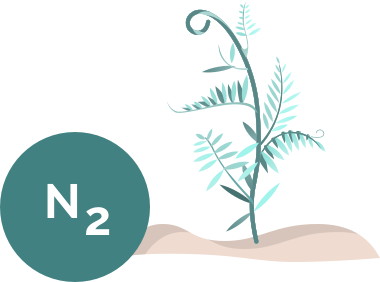Sustainability
Our commitment: to act for a sustainable food
Natural fertiliser
Pulses are notable for their ability to grab nitrogen from the air and return it to the soil. This allows producers to cut back on nitrogen fertilisers.

85 million hectares of legumes
around the world have helped to fix
3–6 million tonnes of nitrogen in the soil.
Low carbon footprint
Pulses require less energy to produce than animal proteins, giving them a smaller carbon footprint and indirectly reducing greenhouse gas emissions.
- Food
- Impact GHG emissions per gram of protein
- Cost Retail price per gram of protein
- Wheat
- $
- Corn
- $
- Beans, chickpeas, lentils
- $
- Rice
- $
- Fish
- $$$
- Soy
- $
- Nuts
- $$$
- Eggs
- $$
- Poultry
- $$
- Pork
- $$
- Dairy (milk, cheese)
- $$
- Beef
- $$$
- Lamb & goat
- $$$
Lighter shade shows emissions from agricultural production, darker shade shows emissions from land-use change.
Sources : GlobAgri-WRR model developed by CIRAD, Princeton University, INRA and WRI (GHG data); USDA and BLS (2016) (US retail price data). Notes : see www.wri.org/resources/data-visualizations/protein-scorecard
Water-efficient
Pulses do not consume very much water. As such, they can be grown in water-stressed areas that might otherwise be overlooked.
Water consumption of legumes compared to other sources of protein :
-
1kg of lentils
1250 L
-
1kg of Poultry
4325 L
-
1kg of goat
5520 L
-
1kg of beef
13000 L
A friend to biodiversity
Pulses have an extensive root system that improves soil structure, allowing water to seep deeper into the ground. Legume growth improves the biodiversity of the soil, making it easier to combat pests.
Through the development of our sector we work closely with our farmers to develop new, more sustainable farming practices, in line with regulatory changes and market demands.




